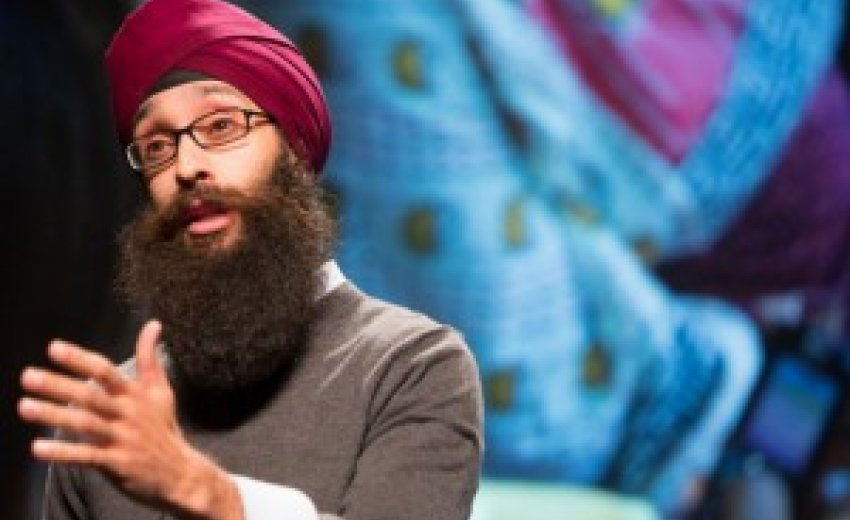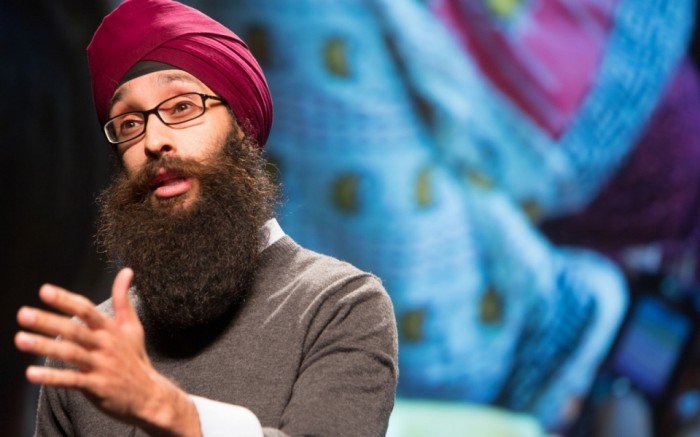 |
| Dr. Prabhjot Singh discusses mobile health at PopTech 2013 in Camden, Maine.PopTech 2013 |
Jan 21, 2014: Dr. Prabhjot Singh, a Columbia University assistant professor of international and public affairs who is also a resident physician in East Harlem in New York, is a practicing Sikh. As part of his faith, he wears an uncut beard and a turban. Last September, he was attacked not far from his home in Harlem by a group of young men who, while yelling “terrorist” and “Osama,” kicked and beat Singh, fracturing his jaw and dislodging some of his teeth.
The attack on Singh is one of the most recent in a string of attacks against Sikhs in the United States since 9/11. Because so few Sikhs live in America, widespread unfamiliarity with the faith leads some to associate the Sikh turban and beard with the images of terrorists like Osama bin Laden. Indian Sikhs carry the holy book of the Sikh religion during a procession near the Golden Temple in Amritsar on Sept. 1, 2011.
 |
| Sikhs during a procession near the Golden Temple in Amritsar, India |
The religion grew out of a society in which both Hinduism and Islam were prevalent, but became a unique faith that taught equality among races and genders and rejected the caste system, religious rituals and pilgrimages. Sikhs worship one God and have a long history of helping the poor and oppressed. They believe in keeping their hair uncut out of respect for God’s creation. The Sikh turban, worn mostly by men but also by some women, covers the uncut hair and signifies commitment to the Sikh faith.
The Sikh Coalition estimates that over 700 hate crimes have been committed against Sikhs since the 2001 attacks. The most deadly of these occurred in August 2012, when a gunman later identified as a member of a white supremacist group opened fire in a Sikh temple in Oak Creek, Wis., killing six Sikhs.
In a Consider This Q&A, Singh shares his perspective on being Sikh in the United States and the ways in which the perceptions of Sikhs in America are changing.
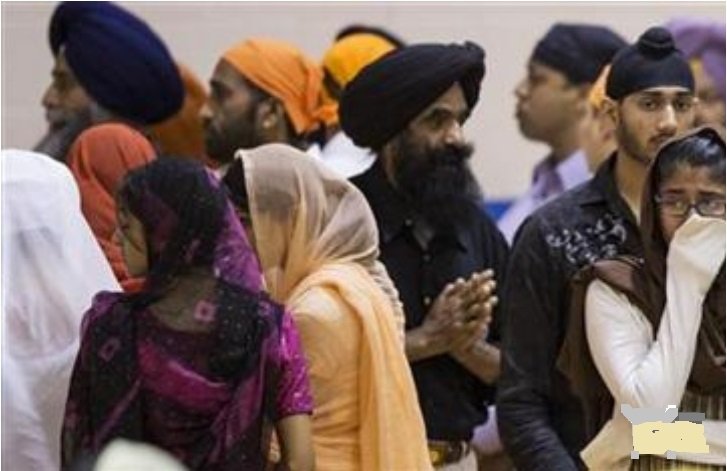 |
| Family members and mourners fight their emotions during a wake and visitation service for victims of last Sunday's attack at a Sikh temple, at Oak Creek High School, in Oak Creek, Wisconsin August 10, 2012. Credit: Reuters/Tom Lynn |
Q. Tell me about your experience as a practicing Sikh in New York. What reactions have you gotten over the years to your turban and beard?
A. However you present yourself, however you offer yourself up is basically how people accept their perception of you. And for the most part, I think there’s generally almost a taboo of asking what may be personal questions. What I’ve generally found is that people really remember me because of my beard and turban. And this for the most part has incredibly positive benefits professionally and personally, (but) I think that the key is that when you get beneath the surface, one layer below: Why does this guy wear a turban? Why does he grow a beard? I think there’s really not that much understanding and there might actually be a taboo about asking anything further. (Sikhs generally have) very positive interactions with other people on a day-to-day basis. But if you go a little bit deeper, I don’t think that there’s that much understanding of who Sikhs are and who they’re not ... their basic belief system or structure and how that manifests itself in day-to-day life.
(For example,) why do you find so many Sikhs working on social justice issues? Is that a coincidence? Is that on purpose? Why do you see them associated with good business ethics or entrepreneurship? How did your cab driver, who’s a Sikh guy, get to be there, and why are there so many of them? I think that these kind of basic questions may not come up that often because it’s not necessarily that often that people encounter Sikhs, so it’s kind of an interesting phenomenon. At least in New York City, you kind of notice and move on.
Q. And what do you think should be done to change this, for people to have more of an understanding?
A. I think that there are three things. On one level, it’s something that every Sikh does every day, which is recognize that they may be the only Sikh person that someone may encounter in their life or in this decade or in New York. And you’re really aware of that, and so at every moment you recognize that you’re an ambassador. And at the very least, you want to convey some sense of your values in just your day-to-day interactions ... The second is that that actually has to be tied to being a Sikh. There’s a lot of people who encounter a Sikh and they think, “Wow, that’s a really nice person” or “(That) was a nice interaction,” but they may not recognize that there’s so much Sikh tradition and faith that leads to that not being an uncommon occurrence. And so tying that to education in schools, advocacy and simply increasing awareness through educational means I think is pretty important. And then the third is a deeper conversation that we have to have in America, which is, it’s actually (OK) to ask questions like “Why do you believe the things you do?” or “What do you believe in? Why do you wear a turban? Do women wear turbans as well? Why do you grow your hair?” These questions — I think as a community we invite them, and as a broader society, I think, it’s really important to encourage that type of really direct questioning in a polite or forthright way. But without that, you never really get beyond the skin deep. And that leaves us in a dangerous position when the skin deep is presented or vilified or shown in media as being associated with a lot of feelings and emotions that may be negative.
Q. In December a man was sentenced to prison for three years for brutally attacking a Sikh cab driver in Seattle, and then, of course, there was the hate crime that happened to you in Harlem, and I know that there have been several such incidents since 9/11. From your perspective, do attacks like this happen a lot?
A. I think one thing is that every single time an attack happens, it’s really felt and known, and word travels very quickly. And so you really feel it in your heart ... It very well could be somebody you know, and it oftentimes is ... As a result, it feels like it happens very often. It certainly feels like there has been an uptick since 9/11. But at the same time, for the same reason that people feel it across the community, it’s also galvanized and brought together a pretty scattered immigrant community which has spent 20 to 30 years just trying to get on its feet economically and socially.
I also see an incredibly socially engaged group of teenagers, kids in their 20s, 30s, who are not only addressing Sikh issues but see it as a broader palette of social justice questions — whether it’s around immigration, safety in communities, bullying, gun violence — and I really see what feels to me to be a kind of renaissance of awareness that we are part of a country that itself is grappling with a lot of dissonance and really a need for social healing.

Q. And from what you have seen, are perpetrators of attacks prosecuted for their actions?
A. There’s nothing in the Sikh faith that says not to prosecute or not hold people responsible ... but what we’ve seen generally is that whenever a Sikh family is asked to move into (a) prosecutorial decision, there’s really a heavy leaning towards reaching for something deeper ... something more based on healing, learning, restorative justice — seeing that this isn’t necessarily even just about the perpetrator. It’s really about a broader set of issues, including education, including outreach.
Q. In your case, did anything happen to the perpetrators?
A. I fully cooperated with the NYPD and the district attorney’s office, and to my knowledge today, nobody’s been caught in the case. So, you know, to the best of my knowledge, about half a mile from where I live, about 20 to 25 people who were involved in my attack are still out there. And it certainly imbues a keen sense that we are a deeply connected community — not always for the best, but most certainly, we’re all in it together.

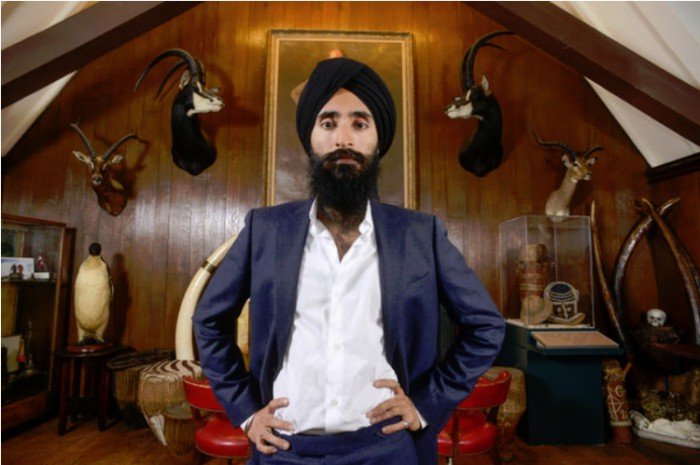 |
| Waris Ahluwalia Casey Kelbaugh for The New York Times |
Q. A Sikh man, Waris Ahluwalia, was featured in a Gap ad that was displayed in the New York City subway system last November. On some of the ads, people wrote racial slurs like “make bombs” and “stop driving taxis.” Gap responded by making the ad their cover photo on Twitter and tweeting their support for Ahluwalia. Was it surprising to you that people wrote racial slurs on the ads?
A. No, not at all. I mean, it’s no more surprising to me that there would be racial slurs on the ad as much as somebody would yell something at me as I walk to the hospital or to my work at Columbia. You know, it happens on a regular enough basis that it certainly doesn’t surprise anyone.
Q. Do you think most companies would have responded the way Gap did in terms of defending Waris and making the ad their cover photo on Twitter to show their support?
A. I don’t think so, not necessarily. I mean, I think that companies and marketing departments are pretty smart. They know their demographic. They know who they appeal to. Gap, I’m sure, has done some deep market research to understand that this is actually something positive for them, and I think they were rewarded for it. (We’ve seen that around the) same time A&E also defended Phil Robertson in “Duck Dynasty” because (the network) also recognized that its constituency would reward it for defending it strongly.
Q. Do you think there’s been an increase in seeing Sikh faces in advertisements and pop culture in the past few years?
A. There definitely has been an increase in just the images of Sikhs around. I have a one-and-a-half-year-old son ... I couldn’t imagine when I was young to go to a Gap and see a picture of a Sikh man or a Sikh woman in the mall. And so in many ways, it’s a clearly different world just on that basis alone. And I think we end up seeing more often stories about people that are not necessarily explicitly recognized for being Sikh — for example, a successful entrepreneur, somebody who’s running for a council seat in New Jersey, a Sikh woman who’s the head of California’s GOP organizing committee — so you end up recognizing and seeing that Sikhs are a part of the fabric of American life.

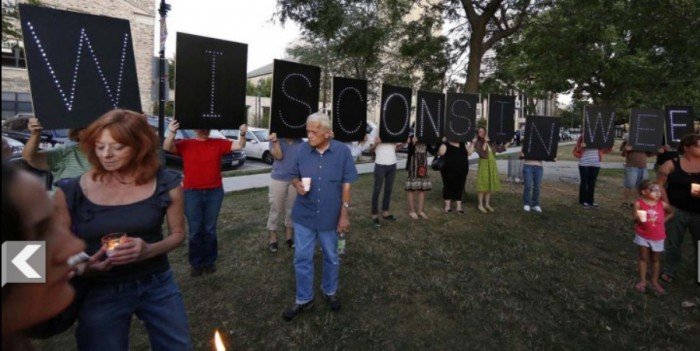 |
| AUGUST 5: People hold a large sign while attending a candle light vigil at Cathedral Square in downtown Milwaukee, Wisconsin August 5, 2012. A shooting during Sunday services at the Sikh temple in a nearby Oak Creek left at least seven people dead, including a gunman, and at least three critically wounded, police and hospital officials said. (Tom Lynn/Reuters) |
Q. In 2012, before you were attacked yourself, you co-wrote an op-ed for The New York Times about the need for the FBI to specifically track hate crimes against Sikhs. Just last year, the FBI decided to start tracking hate crimes against Sikhs. How did you get interested in writing about this issue initially?
A. I think the issue itself is really on the community’s mind. I don’t mean to think of the Sikh community as having one kind of mind. We have a lot of incredibly different perspectives, but 700-plus attacks, hate crimes (against) Sikhs after 9/11 have really led the community to want to understand best how to resolve this problem ... A New York Times op-ed (like mine) is an important visual indicator that something should change, but there is an incredible grass-roots and well-organized movement from such a large range of groups (like the Sikh Coalition and the Sikh American Legal Defense and Education Fund) to see this change happen that when the FBI actually considered doing so, I think they really saw that it had broad support. Congressional hearings later that fall and in the spring underscored just the degree of support that was coming from congressmen, from public advocates, from citizens — some were Sikh, and many were not.
Q. What are some ways in which you think the FBI tracking hate crimes will directly benefit the Sikh community, and does this directly give Sikhs greater protections against hate crimes?
A. Surveillance itself is protective, I experienced that firsthand ... Likely it will happen that other Sikhs will be attacked in hate crimes over the next years. But what we can do is really start to understand where, how and why hate crimes occur against Sikhs or other groups. And that forms the basis of being able to make specific suggestions, becoming proactive instead of defensive and preventative instead of dealing with an aftermath of these events.
Q. Having experienced a violent hate crime yourself, how will this experience impact any further work you do on behalf of the Sikh community to increase awareness or anything else?
A. I think two ways. One, in my own professional work, where I work on community health and health systems in America, I think something that struck me deeply is that violence and safety are as much a part of a community’s sense of its own health as diabetes and heart disease. And I think that really hit home for me just last fall, and as a result, I really had to look more deeply at how I’m going about my work so I could start to understand how to integrate that very personal insight into it. In terms of advocacy for Sikhs, I think certainly the story of what happened to me has traveled quite a bit, and I think it’s important to understand how to be an advocate for the Sikh community and at the same (time) make sure that what we learn and how we share it benefits others. So it certainly deepens my commitment and resolve to being a community advocate. But I think that the biggest takeaway is that community advocacy is both at the local level and for Sikhs across the country.
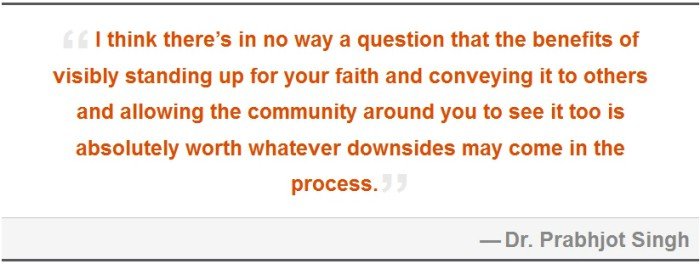
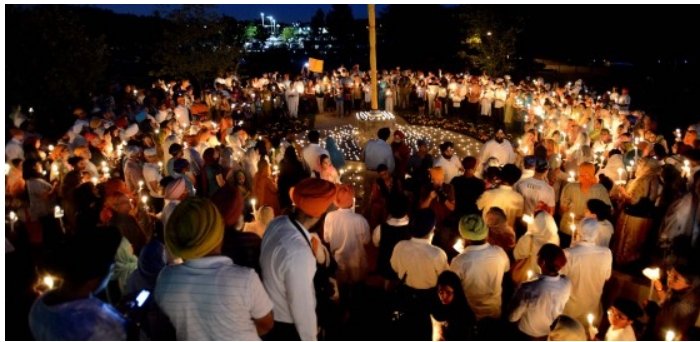 |
| Statement on Oak Creek massacre / sikhactivist.net |
Q. Do you think Sikhs who wear the beard and turban end up being spokespeople or even activists for the Sikh community whether or not they choose to?
A. Absolutely, and I think that that’s core to the tradition. The very founding of the Sikh tradition was based upon a social activism against inequality for women, breaking against the caste system in India, breaking against the Mughal Empire rule and forced conversion to Islam at the time. The very nature of the Sikh identity has always been in the spirit of social activism. You see us so visibly in a turban and a beard for the very basic reason that whenever we’re in a public setting, you always know who a Sikh is and what they stand for and what you should be able to expect, for being able to get help and standing up for people who need it ... I think there’s in no way a question that the benefits of visibly standing up for your faith and conveying it to others and allowing the community around you to see it too is absolutely worth whatever downsides may come in the process.
Dr. Prabhjot Singh’s interview has been condensed and edited. You can learn more about his work in mobile health care by watching the video (below) of his PopTech 2013 presentation. Learn more about Sikh awareness in post-9/11 America by checking out Colleen McKown's article "Turbans do not equal terrorism."
Edited by Leslie Hart

